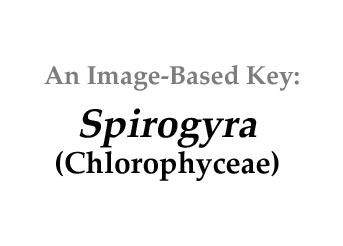|
|
|
|
|
|
|
|
||||
|
Click
on images for larger format |
||||
Name derivation: |
||||
Classification: |
||||
Spirogyra Link 1820; 509 of 651 species descriptions are currently accepted taxonomically (Guiry and Guiry 2013).Class Conjugatophyceae; Order ZygnematalesMoved from the less-advanced green Chlorophyceae.
|
||||
Molecular sequence: |
||||
Based on 26 strains of Spirogyra and 7 strains of Sirogonium, large subunit of RUBISCO (rbcL) sequence strongly supports monophyly of both genera. All species descriptions of Spirogyra are in a single clade except S. maxima that falls within the Sirogonium clade (Drummond et al. 2005).
|
||||
Morphology: |
||||
|
The spiral chloroplast is the
defining characteristic of this species.
It grows
to form slimy filamentous masses of algae. It is capable of reproducing both
sexually and asexually. A filament may fragment into smaller pieces, each one
capable of forming new cells. During sexual reproduction two cells align with
each other and form conjugation tubes which connect the two cells and allow
for the exchange of genetic material.
|
||||
Similar genera: |
||||
|
|
||||
Conjugation: |
||||
|
The most
easily recognizable genus in the class Zygnemaceae
with its spirally coiled chloroplasts is known for its unique sexual
reproduction. Stresses from the environment,
including pH change, temperature change, or desiccation can induce Spirogyra to undergo conjugation by
forming conjugation tubes between male and female gametes. This process allows for the exchange of
genetic information within a population, contributing to the individual
species fitness and adaptability to change.
The structure and formation of this conjugation tube can also be
utilized in identification between the more that 400 various species within
this genus (Wongsawad and Peerapornpisal
2014).
|
||||
Human Uses: |
||||
|
In many
Asian countries, Spirogyra spp. is
valued for human consumption, and is known as an important source of natural
bioactive compounds for antibiotic, antiviral, antioxidant,
anti-inflammatory, and cytotoxic purposes. A specific trans-Himalayan species, S. porticalis, has thirteen known bioactive chemotypes
with phyto-pharmaceutical importance including
fatty acid esters, sterols, unsaturated alcohols, and alkynes. These dominant components contribute to the
high antioxidant capacities in a methanol media as well as high phenolic content, diverse bioactive phyto-chemotypes,
anti-carcinogenic properties, anti-hypoxic, and anti-stress attributes. This species could potentially be utilized
as a sustainable source of drugs for human consumption (Kumar et al. 2015).
|
||||
Cancer Chemopreventative: |
||||
|
Spirogyra neglecta possesses
cancer chemopreventitive compounds and activity
when examining diethylnitrosamine-initiated preneoplasic lesions (having a high risk of becoming
malignant) in rat livers. As humans in
Asian countries including Thailand commonly consume this species, various
doses ranging from daily consumption to 4x overdose were not toxic in the
rats. These doses reduced the number
of glutathione-S-transferase placental (GST-P)
positive foci in the treated rat livers.
These GST-P foci are directly correlated to the development of hepatocellular carcinoma in rats, so treating the rats
during the early stages of GST-P development helps in preventing the
proliferation of these cancerous cells (Thumvijit
et al. 2014). This could have major
implications toward cancer study and treatment for similar liver cancers
found in humans. |
||||
Habitat: |
||||
|
Freshwater
.
Widespread in freshwater habitats worldwide. Filaments usually found as
free-floating masses or ‘clouds’ resting on sediment. |
||||
References: |
||||
|
Drummond, C.S., J. Hall, K.G. Karol, and C.F. Delwiche 2005. Phylogeny of Spirogyra and Sirogonium (Zygnematophyceae)
based on rbcL sequence data. Journal of Phycology
41:1055-1064. Guiry, M.D. and G.M. Guiry 2013. AlgaeBase. World-wide electronic
publication, National University of Ireland, Galway. http://www.algaebase.org; searched on 22
May 2013. Kumar J., P. Dhar, A.B. Tayade, D. Gupta,
O.P. Chaurasia et al. 2015. Chemical Composition
and Biological Activities of Trans-Himalayan Alga Spirogyra porticalis (Muell.) Cleve. PLoS ONE 10(2): e0118255. Nees, C.G.
1820. Horae
physicae Berolinenses collectae ex symbolis virorum doctorum H. Linkii...; edicuravit Christianus Godof. Nees ab Esenbeck. pp. [i-xii],
1-123, [4], 27 pls. Bonnae
[Bonn]: Sumtibus Adolphi
Marcus. Thumvijit T., S. Taya,
C. Punvittayagul, Y. Peerapornpisal
and R. Wongpoomchai 2014. Cancer Chemopreventive Effect of Spirogyra neglecta (Hassall) Kutzing on diethylnitrosamine-induced
hepatocarcinogenesis in Rats. Asian Pacific Journal
of Cancer Prevention 15: 1611-1616. Wongsawad P.,
and Y. Peerapornpisal 2014. Morphological and
molecular profiling of Spirogyra
from northeastern and northern Thailand using inter
simple sequence repeat (ISSR) markers. Saudi Journal of Biological Sciences
21: 391-510. |
||||


















